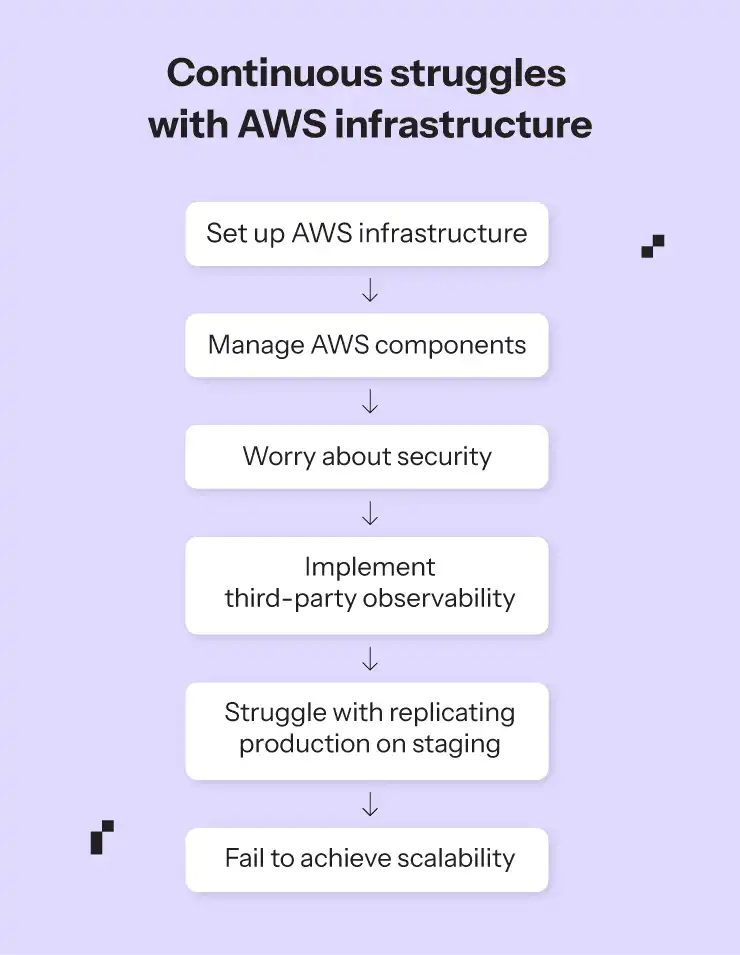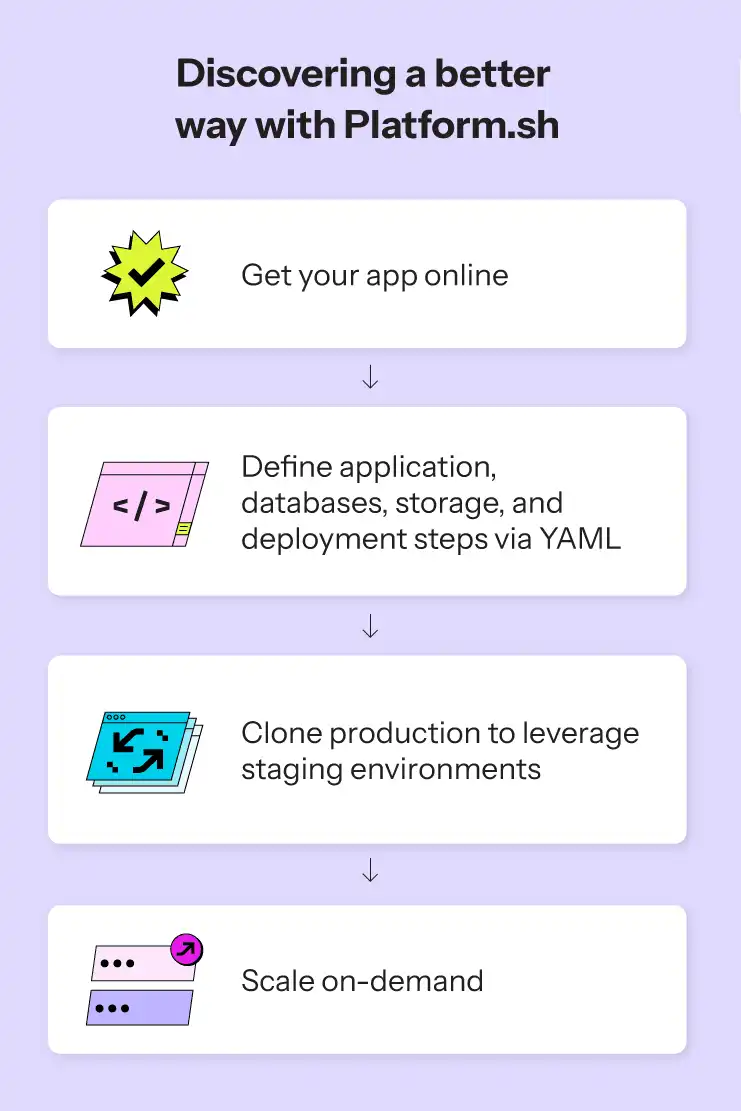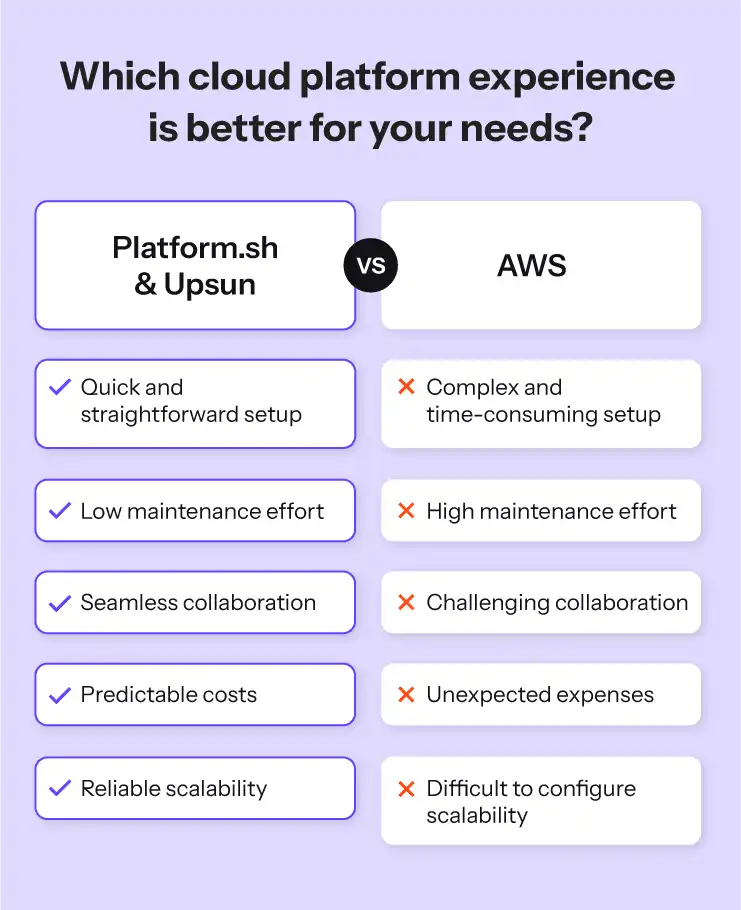
Customer transformation: from AWS struggles to seamless scaling
PaaScloudinfrastructureDevOpsautomation
18 September 2024
If you’re an engineer in a non-tech industry, managing a cloud infrastructure can feel like an endless cycle of putting out fires. I know the frustration—site crashes during critical promotions, complex cloud setups that demand expertise you don’t have, and the sinking feeling of realizing the solution you bet on isn’t delivering.
In this article, I’ll walk you through my journey, from battling AWS’s complexities to finding a better way with Platform.sh and then Upsun. By the time you finish reading, you’ll have insights on how to avoid the same mistakes I made and discover a cloud platform that lets you focus on what really matters: scaling your business.
The Struggle with Cloud Complexity
When I joined a century-old food and beverage company as their lead engineer for all things web, I had a clear mission: deliver exceptional value to our customers by ensuring our e-commerce platform remained solid, especially during peak-traffic times. While the company had a strong technical team for local network management and line operations, the realm of web infrastructure was completely new territory.
Key Challenges We Faced:
- Scalability Issues: Our web application setup was overwhelmed with challenges. Despite our efforts, true scalability felt out of reach. Replicating our production environment seemed nearly impossible, making troubleshooting a nightmare.
- Staging Environment Woes: Without an efficient way to create a reliable staging environment, we lacked confidence in our code’s performance in production.
- Security Concerns: Security was another major concern–both in terms of code integrity and access management. We’d often build solutions locally, only to encounter unforeseen issues once they hit production.
Searching for a solution, AWS seemed like the obvious choice. The buzz around it as a trending IaaS model promised control all the way up to the OS level, with the industry promoting its scalability and stability. I was convinced it was the silver bullet we needed, and I pushed hard for our company to invest in cloud infrastructure. But after making the switch, I quickly realized it wasn’t as simple as it seemed.
The Tough Reality of DIY Cloud Infrastructure
Managing an IaaS platform like AWS turned out to be far more complex than we anticipated. Instead of focusing on development, we were caught up in the demands of infrastructure maintenance—covering everything from security to scaling.
AWS is powerful, but it’s also complex. Setting up auto-scaling groups, managing load balancers, and configuring firewalls became a full-time job. And despite the countless hours spent, our site’s performance didn’t improve—in fact, it got worse. We struggled to reproduce bugs, making them nearly impossible to fix, and I never managed to get AWS’s scalability features to work properly.

I assured my boss that AWS was the solution, but soon things started falling apart. Instead of delivering features, I was stuck firefighting—development didn’t align with staging, staging didn’t align with production, and our bug backlog kept growing. Our big plans to scale BTC efforts faltered as we struggled to support our current audience. Deadlines were missed, and the stress of managing the infrastructure was taking its toll. It was clear that we needed a different approach.
Discovering a Better Way with Platform.sh
After several months of fighting with AWS, I had to admit to my boss that our approach wasn’t working. That was a tough conversation, but thanks to a recent conference, I had discovered Platform.sh—a PaaS (Platform as a Service) that promised to handle all the heavy lifting without the steep learning curve of AWS. Unlike the various IaaS cloud providers I'd investigated, Platform.sh offered the perfect middle ground: allowing us to focus on development while it took care of all the infrastructure. It just worked. All that was needed from me was a little YAML.
We transitioned everything over to Platform.sh in a matter of weeks. The setup was straightforward, and I was blown away by how easy it was to deploy our applications. Creating a new staging environment was as simple as creating a Git branch in our code. Syncing data between production and development environments was automatic, eliminating the manual steps that used to slow us down. Suddenly, all the issues we’d been struggling with—scalability, stability, security, and deployment headaches—were no longer problems.

While on AWS, we often struggled to support our doubling traffic— experiencing performance degradation and often significant downtime, but most importantly lost revenue. But after switching to Platform.sh, we handled 900% increases in traffic seamlessly, ensuring consistent sales and customer satisfaction.
The Power of Upsun: Taking Platform.sh to the Next Level
Now, Platform.sh has evolved into something even more powerful with Upsun. Upsun takes Platform.sh self-service to the next level by offering additional features and even more streamlined deployment processes. For companies like ours, transitioning from an IaaS to a PaaS model meant that we no longer had to manage the complexities of infrastructure. Instead, we could focus on what truly mattered: building and deploying efficiently. With PaaS, we gained the flexibility to scale and deploy without the need for a large team of infrastructure experts.
Upsun benefits from the same great features as Platform.sh and tacks on even more features to enable companies, especially in the non-tech space like the food and beverage industry, to spend more time on innovation and less time on maintenance.
Upsun gives us vertical scaling with Explicit Resource Allocation, providing precise control over CPU, RAM, and storage, which makes scaling incredibly flexible. The usage-based pricing model is a big win for us, ensuring transparency by charging only for what we actually use. Horizontal scalability means we can easily expand containers as needed, and everything is accessible through the Upsun CLI, which really streamlined our operations.
Here’s a quick comparison of what we dealt with before and what Upsun offers:
| Feature | AWS Experience | Upsun Experience |
| Environment Setup | Complex and time-consuming | Quick and straightforward |
| Scalability | Difficult to configure; inconsistent results | Automatic and reliable |
| Maintenance Effort | High; required specialized knowledge | Low; managed services handle most tasks |
| Collaboration | Challenging due to access management complexities | Seamless with instant data cloning |
| Cost Efficiency | Unexpected expenses due to resource estimation complexities | Predictable and optimized costs |
The Real Impact
With Upsun, I could finally focus on what I was hired to do—innovating —rather than getting bogged down by infrastructure challenges. We didn’t have to worry about whether our site could handle the next big spike in traffic or if our staging environment was out of sync with production. Upsun handled all of that, so I didn’t have to.

Post-migration, leveraging tools like Blackfire (now built as an Upsun product!), our page load times improved by 35%, directly enhancing user experience and conversion rates. Our development team could finally focus on innovating rather than troubleshooting, leading to a 20% increase in feature releases over six months. We also experienced fewer unexpected downtimes, boosting our customers’ trust in our brand and leadership confidence in our ability to innovate for the customer.
The Takeaway
Deploying to the cloud can be daunting, especially for companies that don’t have a dedicated tech team. My experience with AWS taught me that the promises of scalability and stability often come with hidden complexities that can be overwhelming. But with Upsun, you can bypass those challenges and focus on what you do best.
If you’re tired of wrestling with complex cloud infrastructures and want to reclaim your time for true development work, consider exploring what Upsun can offer. Take it for a test drive and experience seamless deployment and scalability firsthand. Trust me, I’ve been there—and Upsun is the solution I wish I had from the start.
Your greatest work
is just on the horizon
CompareVercel alternativeAmazee alternativeHeroku alternativePantheon alternativeManaged hosting alternativeFly.io alternativeRender alternativeAWS alternativeAcquia alternativeDigitalOcean alternative
Join our monthly newsletter
Compliant and validated
